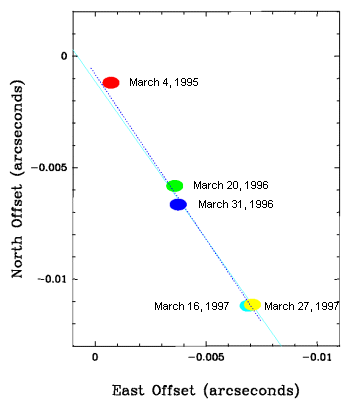
Sgr A*
Observed 3/95-3/9743 GHz
VLA Image by J-H Zhao
VLBA Data by M. Reid,
et al.
We can measure how fast our solar system is moving by observing how Sgr A* changes in relation to a very distant object, outside the Milky Way. This is comparable to riding a carousel and watching the scenery glide behind the center support. It is neither the background nor the carousel support that actually move, but the rotation of the observer which causes this effect. In this case, the movement of the sun causes the apparent position of Sgr A* to change.
The experiment uses the quasars 1745-283 and 1748-291 (named for their
locations in our sky) as fixed points, and compares the apparent change
in position of Sgr A* to those points (see below, left figure). After observations
over the course of two years, the results (right figure) indicate that
the Sun takes 226 million years to circle the galaxy. The experiment also
lends credence to the theory that Sgr A* is in fact a supermassive black
hole, because the mass and density required to cause this movement are
far beyond that of common objects, such as stars or pulsars.
-Lisa Foley
500,000
mi/h = 223 km/s |
 |